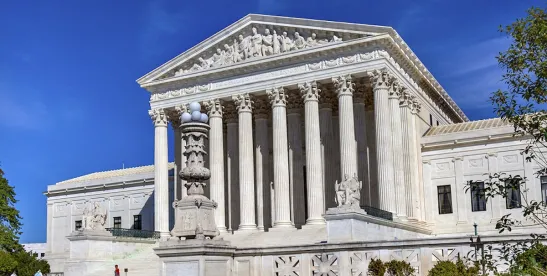The US Supreme Court’s recent decision in Loper Bright v. Raimondo has reset the regulatory landscape in the United States. The court’s decision overturned the longstanding Chevron deference doctrine (“Chevron deference”) that courts had relied upon for almost 40 years when evaluating whether to defer to federal agency rulemaking and case adjudications. Courts applying Chevron deference permitted an agency’s interpretation of ambiguous statutory language to stand, so long as it was deemed a reasonable interpretation of the implementing statute. The Supreme Court’s ruling in Loper Bright opens the door for courts to provide their own interpretations of federal statutes in such circumstances. This article addresses the impact this significant decision may have in the labor and employment arena.
NLRB Impact of Loper Bright
The National Labor Relations Act (“NLRA”) gives the National Labor Relations Board (“the Board” or “NLRB”) the statutory authority to make necessary rules and regulations to effectuate the provisions of the NLRA, including the express authority to prevent unfair labor practices and to oversee union elections.
Unlike most federal agencies, the Board relies almost exclusively on case adjudications instead of traditional rulemaking to create binding interpretations of the NLRA. The Board—which consists of five members appointed to staggered terms by the President—hears cases involving unfair labor practices filed by the General Counsel. Much like a court, the Board issues orders explaining its applications of the NLRA to the cases brought before it.
Though the Board’s case-by-case approach resembles traditional litigation, the Board does not adhere to the same stare decisis principles that courts do. Its membership is subject to frequent change, and whenever a new Board majority disagrees with a prior precedent, it often overrules that precedent. In recent years, the Board has “flip-flopped” on a number of key statutory interpretations, including: the meaning and scope of “concerted activity” under the NLRA; the definition of and circumstances giving rise to a joint employment relationship; the size and composition of appropriate bargaining units in union elections; and whether and to what extent non-union employees have the right to representation during disciplinary interviews—just to name a few. The Board’s near-constant flip-flopping has become, as one court of appeals put it, a “fact of life in NLRB lore.”
Chevron deference has certainly played a role in the Board’s shifting precedents. Under Chevron, there has been little judicial obstacle to the Board routinely changing its interpretation of the NLRA, even on threshold questions such as its own authority to regulate certain activities in the first place. Appellate courts have deferred to the Board’s interpretations of the NLRA so long as it provides a “reasonable” construction of the NLRA, notwithstanding the Board’s own prior inconsistent interpretations.
The Loper Bright decision may act to curb the Board’s flip-flopping and add some much-needed accountability and stability to this area of the law. That said, there is no guarantee that courts will adopt employer-friendly interpretations of the NLRA. Loper Bright empowers the courts to adopt the best interpretation of a statutory ambiguity. They could just as easily adopt some of the NLRB’s more-employee friendly positions. Either way, the courts’ interpretations of the NLRA should eventually acquire a degree of permanence that the Board’s interpretations did not always hold in the Chevron era.
There remain lingering questions about the full impact that Loper Bright will have on the NLRB. The Board, for its part, has come out swinging, suggesting that it should continue to enjoy deference based on the agency’s particularized expertise and based on Supreme Court precedent that pre-dated Chevron. And Section 10(e-f) of the Act grants the Board’s factual findings a high degree of deference in any event, so long as they are based on substantial evidence. Most NLRB cases turn on the facts as opposed to interpretations of ambiguities in the law. These cases are unaffected by Loper Bright. Consequently, the full impact of Loper Bright on the NLRB remains to be seen.
OSHA Impact of Loper Bright
The Occupational Safety and Health Administration (“OSHA”) is authorized by the OSH Act to promulgate workplace health and safety standards “whenever the Secretary…determined that a rule should be promulgated in order to serve the objectives of this Act.” 29 U.S.C. §655(b). Courts historically have deferred to OSHA’s authority, including on the basis of Chevron deference. The Loper Bright decision has changed the landscape and OSHA’s rulemaking activity now should be subject to additional judicial scrutiny.
First, on the standard front, OSHA relies on its interpretation of the OSH Act to justify its workplace standards or administrative rules. The decision in Loper Bright will allow employers to challenge new or existing OSHA standards as exceeding OSHA’s authority under the OSH Act. For example, an employer could argue that a particular OSHA standard does not advance the health and safety of workers, and therefore exceeds OSHA’s statutory authority. While courts would have previously deferred to OSHA’s reasonable statutory interpretations, such deference no longer applies. In a 2020 case, the DC Circuit specifically held that Chevron entitled the Secretary of Labor to deference with respect to the applicability of a safety-standard regarding eyewash stations to construction industry employers, even though, as originally passed, the regulations only applied to federal contractors. Kiewit Power Constructors Co. v. Sec'y of Lab., U.S. Dep't of Lab., 959 F.3d 381, 385 (D.C. Cir. 2020). Such deference would no longer protect OSHA after Loper Bright.
The regulated community may soon see the impact of Loper Bright if employers challenge OSHA’s new proposed standard to regulate workplace heat exposure. The long-anticipated heat standard applies to indoor and outdoor workplaces at designated heat triggers and imposes new requirements related to mandatory paid rest breaks, access to shade or cooling areas, and acclimatization for new or returning employees. Of course, mitigating the risk of heat exposure is not an exact science and OSHA is attempting to hold employers responsible for environmental factors outside their control that can change quickly. As such, many observers expect challenges to the proposed rule. Assuming these challenges materialize, courts will presumably apply their own judgment when assessing whether the proposed standard comports with the legislative delegations of authority in the OSH Act.
OSHA also recently enacted its Worker Walkaround Rule, which allows employees to select representatives to accompany them on OSHA inspections, even if those representatives have no expertise or affiliation with the workplace. OSHA justified its revised regulation on its interpretation of Section 8(e) of the OSH Act, which states “a representative of the employer and a representative authorized by his employees” could attend workplace inspections. In the Walkaround Rule, OSHA took a broad reading of “representative authorized by his employees” to include virtually any third-party, without any formal process of employee recognition. Business groups already have filed challenges to the rule. While the Supreme Court said it would not re-visit previous regulatory challenges decided under the Chevron standard, the challenges to the Walkaround Rule have not yet been decided. In light of Loper Bright, OSHA likely will receive less deference on its interpretation of “representative authorized by his employees” and courts will have to exercise their independent judgment to determine whether the Walkaround Rule is a reasonable exercise of OSHA’s authority.
DOL Impact of Loper Bright
Loper Bright will also have a potentially significant impact in the area of wage and hour law. For decades, the US Department of Labor (“DOL”) has primarily focused on enforcing the Fair Labor Standards Act (“FLSA”) and other wage and hour laws by promulgating extensive regulations, which, until now, have enjoyed considerable deference under Chevron. The Loper Bright decision could open the door to challenges to even long-standing wage and hour regulations and could reshape how the DOL approaches rulemaking in the future.
Most directly, recent rules issued by the Wage and Hour Division of the Department of Labor may provide some of the earliest test cases for the impact of Loper Bright, including final rules (i) increasing the salary threshold for the FLSA white-collar overtime exemptions and (ii) defining independent contractor and tip credit status.
Those rules and others—already the subject of multiple legal challenges—are likely to face greater scrutiny based on the Loper Bright decision.
The end of Chevron deference has significant implications for both the current and previous DOL rules establishing minimum salary thresholds for white-collar exemptions. In Mayfield v. U.S. Department of Labor, the Western District of Texas rejected a challenge to the DOL’s 2019 overtime regulation, which raised the minimum salary threshold to $684 per week, relying squarely on Chevron deference to decide that the DOL had authority to implement a salary-level test in defining the white-collar exemptions. That ruling is presently on appeal before the Fifth Circuit, which will hear oral argument on August 7, 2024. Just days after the Supreme Court’s ruling, the Fifth Circuit asked the parties for briefing on the impact of Loper Bright on the case.
In the time that the Mayfield case has been pending, the DOL published a new overtime rule, further increasing the minimum salary threshold to $844 per week effective July 1, 2024. In Texas v. DOL, within hours of the Supreme Court’s June 28 decision, the Eastern District of Texas relied on Loper Bright to grant a preliminary injunction blocking the implementation of the 2024 overtime regulation with respect to employees of the state of Texas only. Three days later, on July 1, 2024, a judge in the Northern District of Texas declined to issue a nationwide injunction preventing the implementation of the July 1 salary threshold increase, explaining that the summary judgment stage was more appropriate to decide if the rule exceeds the DOL’s statutory authority. The court, however, intends to rule on the merits (i.e., decide whether the rule exceeds the DOL’s statutory authority) before the further increase is scheduled to take effect on January 1, 2025.
Notably, two factors discussed in Loper Bright suggest that the salary basis requirement is less susceptible to challenge than other DOL regulations: (i) the FLSA expressly delegates authority to the DOL to define the white-collar exemptions and (ii) the DOL has used some form of a salary basis test since the FLSA’s enactment in 1938.
Industry groups have also brought Loper Bright to the attention of courts in lawsuits challenging the DOL’s most recent independent contractor and tip credit rules.
The 2024 independent contractor rule (“2024 Rule”), which took effect in March, rescinded a prior Trump-era rule (“Prior Rule”) that established a five-factor test to determine whether an employee is an independent contractor, with a focus on the individual’s control over the work and opportunity for profit or loss. The 2024 Rule returns to the totality of the circumstances analysis that courts applied before the Prior Rule. The ultimate inquiry of the 2024 Rule is whether the worker is economically dependent on the employer. On July 1, business groups challenging the 2024 Rule filed a notice of supplemental authority in Coalition for Workforce Innovation v. Su claiming that Loper Bright supports their argument that the DOL acted arbitrarily and capriciously. If the challenge is successful, the 2024 Rule would be vacated and the Prior Rule reinstated.
In contrast to the salary basis regulation, the independent contractor rule is likely to face greater scrutiny post-Chevron because Congress did not expressly delegate authority to the DOL to define “independent contractor” and it is a clear example of an agency “about-face” under a new administration.
In 2021, the DOL published the 80/20 Rule, a final rule establishing limits on the amount of time employers may require tipped employees to perform non-tipped work and still pay the lower tipped minimum wage. The Rule states that an employer loses the tip credit if an employee spends (i) more than 20% of their workweek on non-tipped duties or (ii) more than 30 continuous minutes per shift on non-tipped duties. During the previous administration, the DOL issued a final rule that would have eliminated the 80/20 Rule, which at the time was a longstanding agency policy. The current administration, however, delayed and ultimately rescinded the provisions involving the 80/20 Rule. In July 2023, a Texas federal court in Restaurant Law Center v. U.S. Department of Labor applied Chevron deference to uphold the 80/20 Rule as a reasonable exercise of the DOL’s rulemaking authority under the FLSA. The restaurant associations appealed the decision and, on July 2, 2024, told the Fifth Circuit that the DOL’s 80/20 Rule must be set aside and vacated under the Loper Bright standard.
The impact of Loper Bright will be very circumstance-dependent. Loper Bright makes clear that prior cases upholding specific regulations under the Chevron framework remain controlling precedent, but at the same time, the Supreme Court left open the possibility of relying on Loper Bright to overturn the reasoning underlying those prior holdings. So to the extent old regulations have been previously challenged and upheld, the DOL may find shelter in stare decisis. But it may be risky for the DOL to rely on the reasoning of those old cases—particularly if they rely on Chevron deference—to support new regulations.
Even old regulations could be overturned, however, if they were not previously challenged and upheld. To that end, in Corner Post v. Board of Governors of the Federal Reserve System—a case decided shortly after Loper Bright—the court ruled that the six-year statute of limitations for challenging regulations under the Administrative Procedure Act starts to run when a plaintiff is injured by the agency action, not when the rule is published. This could have a significant impact on the wage and hour field in particular because many foundational FLSA regulations are decades-old, but the employer could identify more recent harm as the underpinning for a challenge of otherwise long-accepted DOL rules.
In the meantime, employers should continue to adhere to the DOL’s existing rules, which remain in full force and effect while these and other legal challenges play out. Notably, absent court intervention, the minimum salary threshold for white-collar exemptions will increase to $1,128 per week on January 1, 2025. Employers can prepare by identifying employees who may be affected and consider options such as reclassification or increasing salaries.
FTC Impact of Loper Bright
In a move that has dominated discussion of the enforceability of non-compete agreements over the last several months, on April 23, 2024, the Federal Trade Commission (“FTC”) approved a final rule banning most non-compete agreements between employers and their workers (the “Final Rule”). However, Loper Bright is likely to ultimately derail the FTC’s attempts to implement this sweeping prohibition, which is currently scheduled to take effect on September 4, 2024. A potentially lengthy legal battle is expected to ensue, but there are practical steps that employers should take now to balance protecting their businesses with staying on the right side of the Final Rule.
The FTC’s Final Rule classifies non-compete agreements with workers as an unfair method of competition in violation of Section 5 of the Federal Trade Commission Act (“FTCA”), which is the statute from which the FTC derives its authority.
Specifically, the Final Rule (1) prohibits any new non-compete agreements with workers (including senior executives) after September 4, 2024; (2) voids nearly all pre-existing non-compete agreements except for those with “senior executives,” also effective September 4, 2024; and (3) requires that employers provide current and past workers with notice that they will not enforce existing non-compete agreements. Existing non-competes with senior executives, which are permitted under the Final Rule, are limited to those entered into with either (a) a business’ president, CEO, or equivalent or (b) an officer of the company who makes more than $151,164 annually and who is in a “policy making” position (i.e., has the final authority to make controlling policy on significant aspects of the business). There will also remain a “sale of a business” exception, which will permit the restriction of competition by a business seller.
The Final Rule does not impact legal claims that accrued prior to the effective date, so it will not impact existing litigation or future litigation based on non-compete violations upon which a company has not yet taken legal action, and which accrue before the effective date of the Final Rule.
Significantly for employers should the Final Rule remain in effect, only the FTC can seek to enforce violations of the FTCA, although employees seeking to get out of non-competes will undoubtedly point to the Final Rule as justification to avoid an injunction or damages premised strictly on non-compete violations, as opposed to breaches of non-solicitation or confidentiality agreements, which are not subject to the Final Rule (so long as they are not deemed to be overly-restrictive, backdoor non-competes).
In addition, the FTCA does not provide for a private right of action. If the FTC decided to prosecute a violation, it would issue a “civil investigation demand,” which is a formal subpoena process that allows the FTC to gather evidence. Then, the FTC would either pursue an adjudication before an administrative law judge, or sue for an injunction.
The Supreme Court issued the Loper Bright decision while two notable lawsuits challenging the Final Rule were pending. The first is Ryan LLC v. Federal Trade Commission, 3:24-cv-986 (N.D. Tex., Apr. 23, 2024), and the second is ATS Tree Service v. Federal Trade Commission, 2:2024cv01743 (E.D. Pa., Apr. 25, 2024). At the heart of these legal challenges is whether the FTC has the authority to implement the Final Rule when the FTCA makes no mention of non-compete restrictions and does not explicitly give the FTC power to create these kinds of substantive rules to prevent unfair methods of competition.
The court in Ryan issued a decision in early July explaining that the court has to independently interpret statutes (like the FTCA), not defer to the agency’s interpretation, and held that the plaintiff would likely be able to succeed in proving that the FTCA does not allow the FTC to create substantive rules to prevent supposedly unfair methods of competition, such as the prohibitions contained in the Final Rule.
This demonstrates that Loper Bright is already having real-world implications and making it more difficult for the FTC to persuade courts that they have the authority to implement the Final Rule when the FTCA does not explicitly give the FTC this power. That said, the Ryan court entered a preliminary injunction in favor of the parties to that case, but did not yet issue nationwide relief.
On July 23, 2024, the court in ATS Tree Services took a different stance than the Ryan court, finding that ATS did not make a showing of irreparable harm, and even if it did, ATS still was unable to demonstrate a likelihood of success on the merits. The court analyzed the FTCA in light of Loper Bright and came to the opposite conclusion of the Ryan court, namely, that the Final Rule was in the scope of the FTC’s rulemaking authority because the FTCA did not distinguish between procedural and substantive rules. This decision is merely a temporary victory for the FTC if the Ryan court makes good on its indications that it will rule in the plaintiffs’ favor, and the Ryan court is still considering issuing a nationwide injunction. The Ryan court has committed to issuing its final ruling on or before August 30, 2024, and summary judgment briefing is ongoing at this time.
As these legal challenges are ongoing, employers should continue to take reasonable steps to prepare in case the Final Rule is not invalidated or stayed while litigation proceeds. Employers should consider the following action items and related points:
- Immediately vet and re-execute alternatives to non-competes, presuming the Final Rule remains in effect. Carefully crafted, valid and enforceable non-disclosure and confidentiality agreements, non-solicitation agreements, and no-hire agreements can serve as effective substitutes for non-competes in that they are alternative ways to prevent company assets (such as proprietary information or talent) from ending up at competitors. We strongly recommend focusing on reviewing, revising and reissuing (if needed) all forms of restrictive covenant agreements intended to protect a company’s legitimate business interests now as a matter of housecleaning and best practices. Even if the Final Rule is vacated, additional restrictions and challenges to non-compete agreements (in particular) are constantly developing, and the risk of employees absconding with business information has never been higher.
- Prepare to give notice. Prepare now to give notice to current and former employees (but not senior executives). This can be a burdensome process for larger employers, so it would be prudent to begin compiling the contact information for the applicable current and former employees. However, employers should hold off on actually sending the notice until the Ryan court takes further action (or some other court issues a nationwide injunction).
- Address the exception for senior executives. First, companies should evaluate which employees clearly qualify as senior executives within the meaning of the Final Rule and have them execute valid and enforceable non-compete agreements prior to September 4, 2024. If you have employees who fall within a gray area with respect to setting policy or do not make enough money to fall within the exemption, but you want them to qualify as senior executives, consider adjusting their roles or salaries closer to the effective date of the Final Rule to satisfy this standard and then present them with new non-compete agreements.
- Consider joining one of the business group plaintiffs in Ryan. It remains to be seen whether the Ryan court will extend relief on a nationwide basis. Additionally, the court left the door open to the plaintiffs to make an argument regarding associational standing, which would extend the court’s ruling to members of the business organization. Therefore, employers should be prepared to join one of the business group plaintiffs on or before September 4, 2024 for a chance to take advantage of the possibility that the court will extend the injunctive protection to members if it does not do so on a nationwide basis, and if it determines that the members have associational standing.
- Consider garden leave. Employers should vet alternatives to non-competes that may allow them to accomplish similar goals. For example, the FTC rule defines a “non-compete clause” as “functioning to prevent” a worker from seeking or accepting new employment after the current employment ends. Under this definition, a garden leave provision (which provides that the employee remains employed with full salary and benefits but is not allowed to perform work) is likely allowed. If the employee failed to provide notice of resignation, then the company could seek an injunction to enforce the written agreement.
- Evaluate the risk. If the Ryan court does not grant a permanent injunction or does not apply it on a nationwide basis, then employers will be exposed to the FTC rule while a lengthy appeals process likely ensues. However, the risk of keeping non-competes in place while the appeals process plays out may be low relative to the reward. The FTCA does not provide for a private right of action, and the FTC is limited to injunctive relief and cannot seek civil penalties if it seeks to enforce the Final Rule against a company it deems is in violation. Given that the FTC would also need to issue a civil investigation demand, a company could choose to act first and sue for declaratory relief in order to pick a favorable forum.
- Challenge the Final Rule. Companies which rely heavily on non-competes and who operate in favorable jurisdictions (or in the same jurisdiction as the pending Ryan case) could consider initiating a new legal challenge (such as a declaratory injunction) or even join the Ryan case as a related case if possible.
In any event, as the viability of the Final Rule remains in question, all employers should be working closely with their restrictive covenants counsel now to best protect their legitimate business interests.
In sum, the long-term impacts of Loper Bright remain to be seen. Employers should be mindful that Chevron deference—once considered settled precedent—is now uncharted territory for the DOL and other agencies in the labor and employment arena.
Reilly C. Moore and Katherine P. Sandberg also contributed to this article.









 />i
/>i

